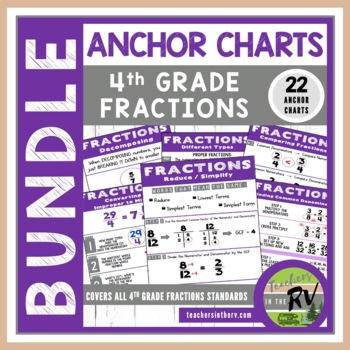Anchor Charts | 4th Grade | All Fraction Standards | 22 Posters
- Zip
Products in this Bundle (11)
showing 1-5 of 11 products
Bonus
Also included in
- Use these all year to cover ALL 4th grade math standards. This resource gives students 74 full pages with step-by-step help on every single 4th grade math standard. You can print them out and hang them up as anchor charts, or have students put them in their notebooks to reference all year long!_____Price $33.95Original Price $48.50Save $14.55
Description
You get 11 full products in this bundle! 22 full anchor charts / cheat sheets that cover all 4th grade Numbers & Operations Fractions standards. There are step-by-step instructions on all anchor charts. You can use these to hang on the wall as anchor chart resources, print them out and put them in binders, and use them as a cheat sheet all year long!
_____________________________________
⭐ BONUS: This can be printed on Standard (8.5 x 11) or Legal (8.5 x 14) paper.
____________________________________
⚫ This Product Includes:
✅ 22 Full Anchor Charts / Cheat Sheets:
✅ 4.NF.1- Different Types of Fractions
✅ 4.NF.1- Tips for Simplifying
✅ 4.NF.1- Reduce / Simplify
✅ 4.NF.1- Equivalent Fractions
✅ 4.NF.1- Equivalent Fractions
✅ 4.NF.2- Comparing Fractions
✅ 4.NF.3- Adding & Subtracting Mixed Numbers (2 charts to choose from)
✅ 4.NF.3- Subtracting Mixed Numbers with Regrouping
✅ 4.NF.3- Subtracting Mixed Numbers with Converting
✅ 4.NF.3- Adding & Subtracting Like Denominators
✅ 4.NF.3- Decomposing Fractions
✅ 4.NF.3- Decomposing Fractions
✅ 4.NF.4- Multiplying Mixed Numbers and Whole Numbers
✅ 4.NF.4- Multiplying Fractions
✅ 4.NF.4- Converting Improper to Mixed
✅ 4.NF.4- Converting Mixed to Improper
✅ 4.NF.5- Denominators 10 & 100
✅ 4.NF.6- Decimal Notation
✅ 4.NF.6- Decimal Place Value
✅ 4.NF.7- Comparing Decimals
✅ 5.NF.1- Adding & Subtracting Unlike Denominators (bonus anchor chart)
✅ 5.NF.1- Finding Common Denominators (bonus anchor chart)
_____________________________________
⚫ Ways to Use:
✅ Wall Anchor Charts
✅ Binders
✅ Cheat Sheets
_____________________________________
⚫ Supports Common Core Standards:
✅ CCSS.MATH.CONTENT: 4.NF.1, 4.NF.2, 4.NF.3, 4.NF.4, 4.NF.5, 4.NF.6, 4.NF.7, 5.NF.1
_____________________________________
⚫ Questions:
As always, if you have any questions, comments, or suggestions before or after purchase please contact us via the Q/A in our TPT store or email us at: teachersintherv@gmail.com. Happy Teaching!
_____________________________________
Check out these products:
•Check out our Bulletin Boards
_____________________________________
Connect with us:
•Visit our blog: Teachers in the RV
•Follow us on: Instagram
•Follow us on: Pinterest






